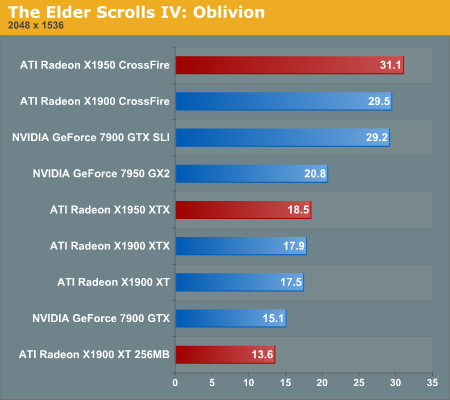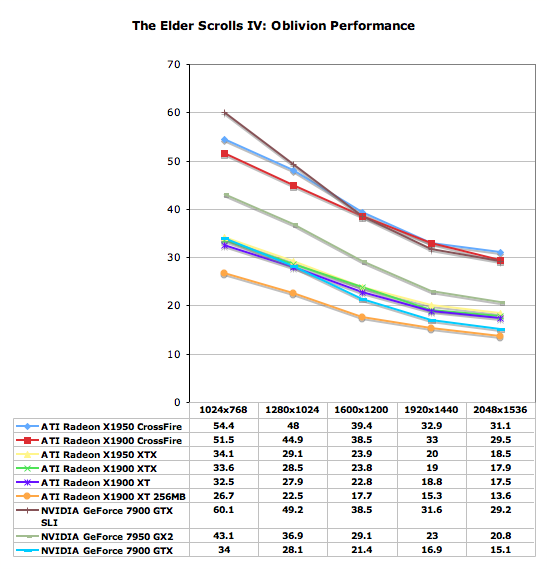ATI's New High End and Mid Range: Radeon X1950 XTX & X1900 XT 256MB
by Derek Wilson on August 23, 2006 9:52 AM EST- Posted in
- GPUs
The Elder Scrolls IV: Oblivion Performance
While it is disappointing that Oblivion doesn't have a built in benchmark, our FRAPS tests have proven to be fairly repeatable and very intensive on every part of a system. While these numbers will reflect real world playability of the game, please remember that our test system uses the fastest processor we could get our hands on. If a purchasing decision is to be made using Oblivion performance alone, please check out our two articles on the CPU and GPU performance of Oblivion. We have used the most graphically intensive benchmark in our suite, but the rest of the platform will make a difference. We can still easily demonstrate which graphics card is best for Oblivion even if our numbers don't translate to what our readers will see on their systems.
Running through the forest towards an Oblivion gate while fireballs fly by our head is a very graphically taxing benchmark. In order to run this benchmark, we have a saved game that we load and run through with FRAPS. To start the benchmark, we hit "q" which just runs forward, and start and stop FRAPS at predetermined points in the run. While not 100% identical each run, our benchmark scores are usually fairly close. We run the benchmark a couple times just to be sure there wasn't a one time hiccup.
As for settings, we tested a few different configurations and decided on this group of options:
| Oblivion Performance Settings | |
| Texture Size | Large |
| Tree Fade | 100% |
| Actor Fade | 100% |
| Item Fade | 66% |
| Object Fade | 90% |
| Grass Distance | 50% |
| View Distance | 100% |
| Distant Land | On |
| Distant Buildings | On |
| Distant Trees | On |
| Interior Shadows | 95% |
| Exterior Shadows | 85% |
| Self Shadows | On |
| Shadows on Grass | On |
| Tree Canopy Shadows | On |
| Shadow Filtering | High |
| Specular Distance | 100% |
| HDR Lighting | On |
| Bloom Lighting | Off |
| Water Detail | High |
| Water Reflections | On |
| Water Ripples | On |
| Window Reflections | On |
| Blood Decals | High |
| Anti-aliasing | Off |
Our goal was to get acceptable performance levels under the current generation of cards at 1600x1200. This was fairly easy with the range of cards we tested here. These settings are amazing and very enjoyable. While more is better in this game, no current computer will give you everything at high res. Only the best multi-GPU solution and a great CPU are going to give you settings like the ones we have at high resolutions, but who cares about grass distance, right?
While very graphically intensive, and first person, this isn't a twitch shooter. Our experience leads us to conclude that 20fps gives a good experience. It's playable a little lower, but watch out for some jerkiness that may pop up. Getting down to 16fps and below is a little too low to be acceptable. The main point to bring home is that you really want as much eye candy as possible. While Oblivion is an immersive and awesome game from a gameplay standpoint, the graphics certainly help draw the gamer in.

Oblivion is the first game in our suite where ATI's latest and greatest actually ends up on top. The margin of victory for the X1950 CrossFire isn't tremendous, measuring in at 6.5% over the 7900 GTX SLI.
As a single card, the 7950 GX2 does better than anything else, but as a multi-GPU setup it's not so great. The 12% performance advantage at 2048 x 1536 only amounts to a few more fps, but as you'll see in the graphs below, at lower resolutions the GX2 actually manages a much better lead. A single X1950 XTX is on the borderline of where Oblivion performance starts feeling slow, but we're talking about some very aggressive settings at 2048 x 1536 - something that was simply unimaginable for a single card when this game came out. Thanks to updated drivers and a long awaited patch, Oblivion performance is no longer as big of an issue if you've got any of these cards. We may just have to dust off the game ourselves and continue in our quest to steal as much produce from as many unsuspecting characters in the Imperial City as possible.
Oblivion does like having a 512MB frame buffer, and it punishes the X1900 XT 256MB pretty severely for skimping on the memory. If you do enjoy playing Oblivion, you may want to try and pick up one of the 512MB X1900 XTs before they eventually disappear (or start selling for way too much).

In contrast to Battlefield 2, it seems that NVIDIA's 7900 GTX SLI solution is less CPU limited at low resolution than ATI's CrossFire. Of course, it's the higher resolutions we are really interested in, and each of the multi card options we tested performs essentially the same at 1600x1200 or higher. The 7950 GX2 seems to drop off faster than the X1950 XTX, allowing ATI to close the gap between the two. While the margin does narrow, the X1950 XTX can't quiet catch the NVIDIA multi-GPU single card solution. More interestingly, Oblivion doesn't seem to care much about the differences between the X1950 XTX, X1900 XTX, and X1900 XT. While the game does seem to like a 512MB of onboard memory, large differences in memory speed and small differences in core clock don't seem to impact performance significantly.










74 Comments
View All Comments
Vigile - Wednesday, August 23, 2006 - link
My thought exactly on this one Anand...Anand Lal Shimpi - Wednesday, August 23, 2006 - link
You can run dual monitors with a CrossFire card as well, the CrossFire dongle that comes with the card has your 2nd DVI output on it :)Take care,
Anand
kneecap - Wednesday, August 23, 2006 - link
What about VIVO? The Crossfire Edition does not support that.JarredWalton - Wednesday, August 23, 2006 - link
For high-end video out, the DVI port is generally more useful anyway. It's also required if you want to hook up to a display using HDCP - I think that will work with a DVI-to-HDMI adapter, but maybe not? S-VIDEO and Composite out are basically becoming seldom used items in my experience, though the loss of component out is a bit more of a concern.JNo - Thursday, August 24, 2006 - link
So if I use DVI out and attach a DVI to HDMI adaptor before attaching to a projector or HDTV, will I get a properly encrypted signal to fully display future blu-ray/hd-dvd encrypted content?The loss of component is a bit of a concern as many HDTVs and projectors still produce amazing images with component and, in fact, I gather that some very high resolutions+refresh rates are possible on component but not DVI due to certain bandwidth limitations with DVI. But please correct me if I am wrong. I take Anandtech's point on the crossfire card offering more but with a couple of admittedly small quesiton marks, I see no reason not to get the standard card and crossfire for the second later if you decided to go that route...
JarredWalton - Thursday, August 24, 2006 - link
I suppose theoretically component could run higher resolutions than DVI, with dual-link being required for 2048x1536 and higher. Not sure what displays support such resolutions with component inputs, though. Even 1080p can run off of single-link DVI.I think the idea with CF cards over standard is that they will have a higher resale value if you want to get rid of them in the future, and they are also more versatile -- TV out capability being the one exception. There are going to be a lot of people that get systems with a standard X1950 card, so if they want to upgrade to CrossFire in the future they will need to buy the CrossFire edition. We all know that at some point ATI is no longer going to make any of the R5xx cards, so if people wait to upgrade to CrossFire they might be forced to look for used cards in a year or two.
Obviously, this whole scenario falls apart if street prices on CrossFire edition cards end up being higher than the regular cards. Given the supply/demand economics involved, that wouldn't be too surprising, but of course we won't know for another three or four weeks.
UNESC0 - Wednesday, August 23, 2006 - link
thanks for clearing that up Anand, news to me!TigerFlash - Wednesday, August 23, 2006 - link
I was wondering if anyone thinks it's wise to get an intel core duo 2 motherboard with crossfire support now that AMD is buying out ATI. Do you think ATI would stop supporting Intel motherboards?johnsonx - Wednesday, August 23, 2006 - link
Of course not. AMD/ATI isn't stupid. Even if their cross-licensing agreement with Intel didn't prevent them from blocking Crossfire on Intel boards (which it almost surely does), cutting out that part of the market would be foolish.
dderidex - Wednesday, August 23, 2006 - link
What's with the $99 -> $249 gap?Weren't we supposed to see an X1650XT, too? Based on RV570? ...or RV560? Something?